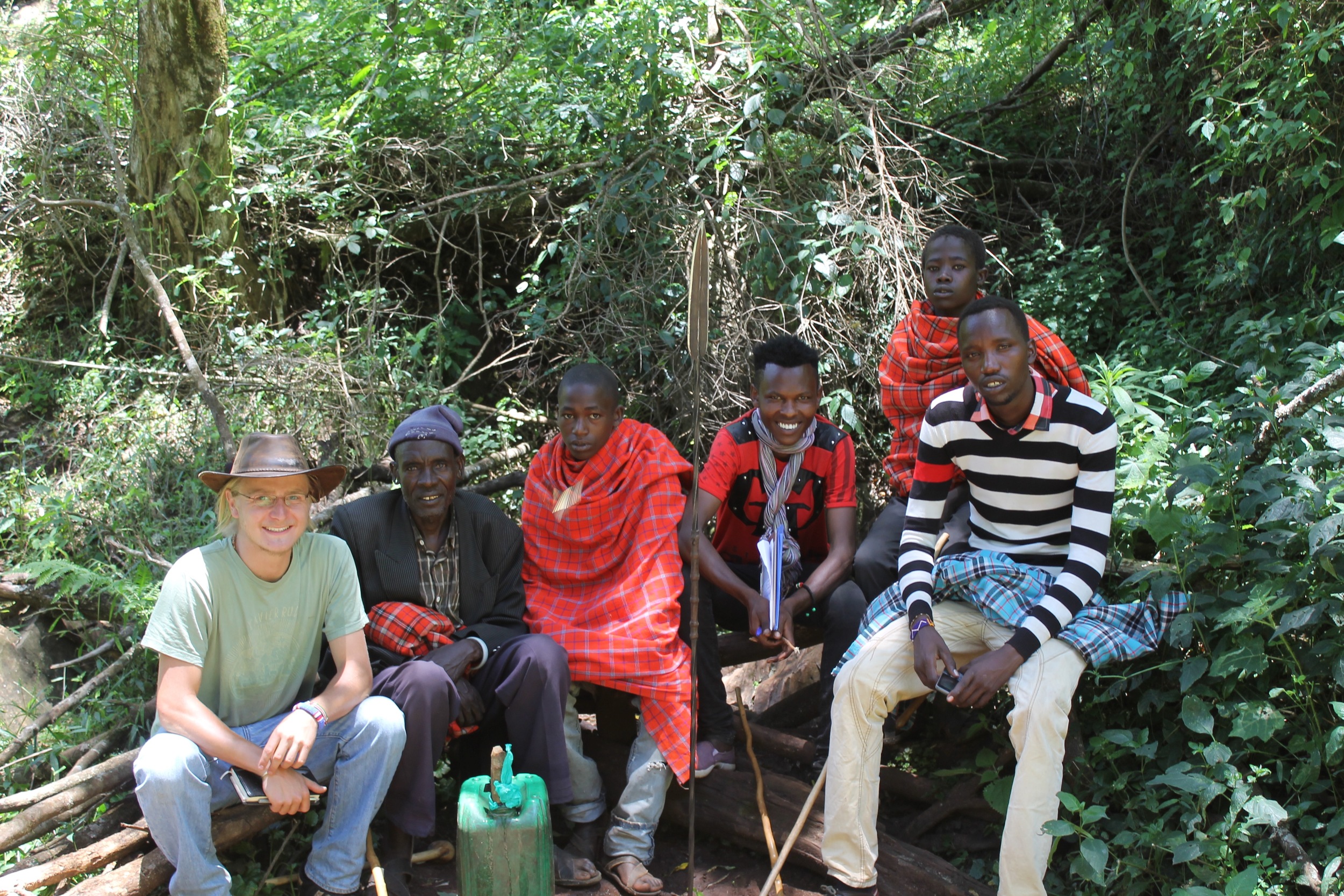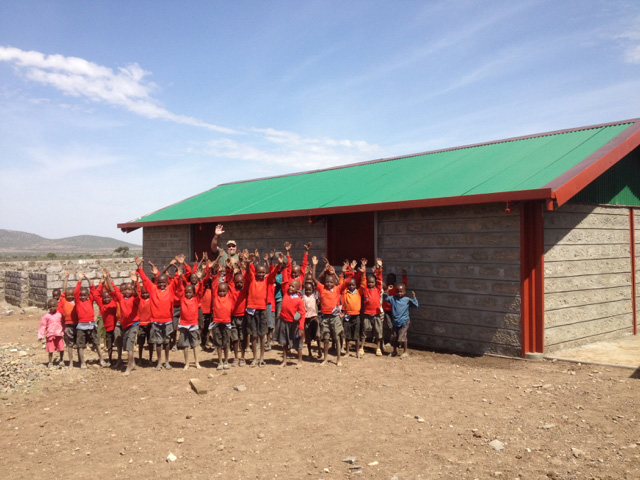
BLOG
Our latest accomplishments, progress reports, & musings.
Internship with Orkonyi Welfare Association, Loita Hills





Michael Barton and Chris Harrell narrate their experience as Africa Exchange interns with Orkonyi Welfare Association in the Loita Hills of Kenya . . .
The Maasai’s second most sacred site after Ol'doinyo Lengai, is the Naimina Enkiyio Forest, (Maa for “Forest of the Lost Child”). High in the Loita hills along the Kenya/ Tanzania border, this highland forest is nestled between the harsh soda flats of Magadi and the expansive savanna of the Maasai Mara. Like many of the world’s remaining natural heritage sites, the future of the Naimina Enkiyio forest is filled with many challenges. Anthropogenic influences, both local and global, will determine this forest’s future. The question arises, who and what will benefit over the next decade of this forest’s future and who or what will suffer the losses?
As an outsider who doesn’t know the deep traditions of the Maasai culture, it is hard to grasp the dynamic nature of their reverence for the Naimina Enkiyio. The feeling first comes a long way before one actually enters the forest. Climbing up the escarpment of the Loita hills from the dusty, dry Narosura plains, one can hardly believe there is a highland forest on the seemingly semi- arid hillsides above you. Yet as the road rapidly ascends to a chilly elevation of over two thousand meters, a literal change of atmosphere can be sensed. Leveling off at the top of the first rise, there is a definite change in the fauna, not yet forest but thick Croton and Oleleshwa bush. This is quickly followed by entering a hidden bowl of savanna grasslands, whose low points are easily defined by strips of Acacia woodland, and its high border ridgelines populated by dense forest.
With too much to see, one’s eyes are drawn to the magnificent height of the Podocarpus trees and the girth of the Strangler Figs. Whilst looking up, the flash of red of a Hartlaub’s Turaco, or the racing black and white of the Colobus monkeys show how many layers of ecological niches this forest must contain. It is quickly apparent that the dynamic nature of the forest will be mirrored in the communities who rely on it. With the question of the management of such an important natural resource, dynamic politics is to be expected.
Our work in the forest was coupled with work in the four Puroko Maasai communities living on the forest’s northern boundary. These four communities, the Kirtilikini, Oltarakwai, Osupuko Oirobi, and the Olemegili make up the newly formed community association called Orkonyil. The Association was developed to give the communities a recognized voice to appeal to the Local and National Governments.
Our role here during the early stages of the new Association, was to help the association and communities to map the complex natural resources they have in the forest and pasture lands, but also to recognize the local human resources present within their communities. Our approach to disseminating this information to both the communities and the Association came through the use of GIS, (Geographic Information System), mapping and resources collection methods.
The GIS mapping portion of the project started with the collection of community resources; those accessible to the whole community, ‘the Commons’. These resources included, schools, clinics, traditional meeting points, churches, duka’s, (local general stores), pasture-lands, and water sources.
Throughout the collection process, we were also able to train a handful of the communities’ youth who had recently graduated from secondary school. During the two-month internship we worked with ten youth from the four communities involved in the Association. These ten ‘Resource Assessors’, (RA), were first introduced to the data collection methods and tools by shadowing us. They would watch and ask questions as we hiked through the forest to service the camera trap grid. They were able to see how the GPS could be used to ‘Mark’, ‘Find’, and ‘Save’ tracks to any destination. Coinciding with the camera trap grid survey we also collected sighting data using an android application called ‘CyberTracker’. This allowed us to customize survey questions, that when answered, built up our GIS with relevant information about the forest. The questions asked had to do with the different kinds of sightings we came across in the forest, such as spoor, markings, poaching, animal sightings and the size of the game trails through the forest. This data revealed some interesting patterns of animal movements such as that of elephant and leopard and reinforced the evidence from the camera traps.
In the final project, we worked on developing and training the RAs in how to use another customized CyberTracker app. This new app was loaded with a survey questions that would help to identify the demographic information from the four communities. Questions were developed to collect data under the two categories of Household information and Livestock information. These questions pertained to issues of household health and education and then livestock health and agriculture practice. With the collection of this geospatial-referenced data, the communities through their Orkonyil Association will more easily be able to recognize the issues faced by the greater community and will be better positioned to address these issues.
Peace, Love, Joy.
As the year draws to a close, we find our selves grateful for all that we have been enabled to do in 2015. Communities, partners and staff join together in wishing you all a blessed Christmas and a Happy New Year!
Integrated Child Development Center Project staff at annual conference at Brackenhurst
My Heart Swells
My heart swells with pride today as Kenya welcomes President Obama to preside over the Global Youth Entrepreneurship Summit. It swells because Obama, a statesman I greatly admire, has ignored critics that would have had him stay at home over security concerns; it swells at the realization that Kenya has such amazing potential in its youth; it swells because in spite of the fact that a visit from such a VIP has inconvenienced many, in true Kenyan fashion the honor of hosting him and the good that might come from his visit outweighs the hassle of barricaded roads and the massive presence of security personnel.
But mainly my heart swells because this is the land of my birth and casting cynicism aside even for awhile is a healthy and rewarding experience. How else are we to find hope for the future? How else are we to power through the problems we know exist and find ourselves in the territory of what is possible? How else are old burdens to be laid down and new opportunities taken up? This is what I am learning from my Kenyan colleagues here. Hope springs eternal, even against all odds. Patience bears fruit. One day the underdog wins. The virtue of humility is to be treasured. Laughing at our shortcomings an not giving up is a way of arriving at where we want to be.
Perhaps I am overcome due to the reality that soon I will be leaving this land to follow a call that is elsewhere. Never mind. I am somehow Kenyan. Yes, I know I am an American as well, but this is the land that has nurtured me and formed me and I have given it my best years. My roots are here. They cannot be transplanted. I am a "third thing." And today is my day - the best of Kenya and America unite if only for a moment in time.
Sam Harrell
No Innocents in the Battle for Environmental Sustainability
by Sam Harrell
Discussions and debates on the issue of our environmental future often generate more heat than light. We tend to be polarized into camps when such discussions take place. Some have their eyes only on climate change, others on population control. Still others swear that new technologies will save our planet from its current path toward destruction.
The fact is, all of these elements are important. There is no need to take sides. Environmentalists have long realized that the inter-relationships between such factors hold keys to our future. Take for example a simple formula used in the field of Environmental Science that illustrates these inter-relationships. I = PAT. The “I” in the formula is (environmental) Impact, “P” is population growth, “A” is affluence or consumption levels, and “T” represents technological efficiency. Thus, global environmental impact is determined by relationships between population growth, affluence/consumption levels and the technologies available for processes such as energy production, manufacturing, food production and transportation.
Developed, industrialized countries often point a finger at developing countries like Kenya with skyrocketing birth rates that threaten to overburden existing resources. They are right. Developing countries in turn tend to blame developed, industrialized countries for too much pollution (China) or conspicuous consumption (USA). They are also right. All of us, it seems, are desperate for new technologies that will allow us to do more with less. Fine, but not a comprehensive solution since many of these technologies, like GM food production, hydraulic fracturing for natural gas production, etc., have serious ecological costs of their own and tend to ignore many of the underlying issues.
The reality is that we are all complicit in environmental sabotage. There are no innocents in the battle for sustainability. The burgeoning population of our planet is indeed catastrophic and will in the near term overwhelm any technological advances toward greater efficiency. Can you imagine a Nigeria with almost 400 million or a Kenya with almost 100 million people in 35 short years from now (by 2050)? We can’t just blame China for raping the environment and pollution when the bulk of goods they produce are exported for use elsewhere. The hard reality is that this planet has provided us with a limited resource base and demand for these resources will very soon outstrip supply. Consumption levels in the affluent West certainly lead to the overexploitation and waste of limited natural resources, even as those resources are procured elsewhere. The appetite for consumer goods only increases as developing countries transition to industrialized countries with all the attendant appetites. Technology, as great as it is, cannot be counted on to counter these excesses.
We need to wake up to the fact that there simply are no shortcuts. Our very survival depends on reducing population growth to replacement levels and more equitable distribution of consumptive resources so that those who have too little will have enough. Since resources are limited, Western, developed nations will have to trim the fat. New technologies will greatly assist us on this journey but wholesale reliance on the same will be to our detriment.
New Classroom Completed
We celebrate the completion of a new classroom block at Nkasioki which is growing from an initial kindergarten in 2005, to a full fledged primary school.




Even as school children dug for water in the dry bed below, we took time to rehabilitate another suspended bridge near Siana in the Mara so that when the waters do rage, the primary school children will be able to cross safely to school.
Scholarships for Secondary School
This month we launched a new initiative under our Change for Children Program called ICDC Scholars. 8 years ago we began opening Integrated Child Development Centers around the country to meet the needs of young children at risk. Today, many of those same children have begun graduating from primary school (8th grade). The ICDC Scholars progam will make it possible for one child at a time from each ICDC unit to qualify for a full secondary school scholarship. We hope to eventually support 8 scholars at any given time. This year we chose 3 scholars who are now enrolled and beginning their secondary education! We are grateful for those that are eager to help us help these children with a continuing education. Thank you!




